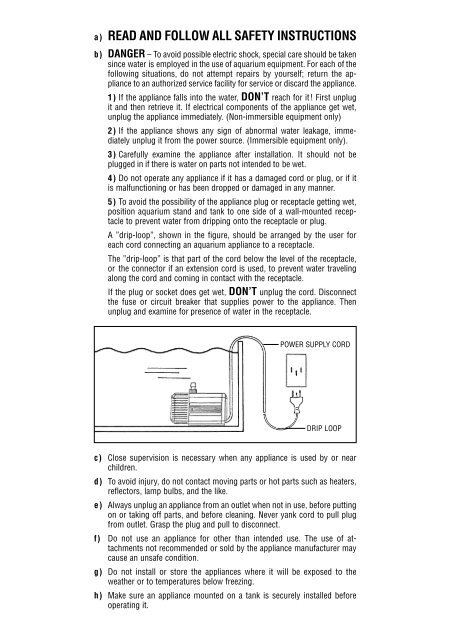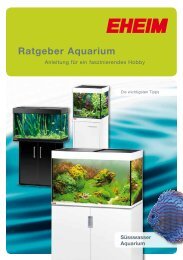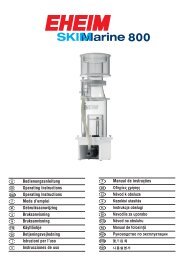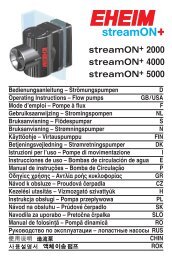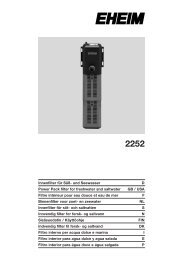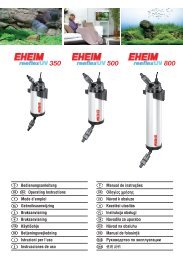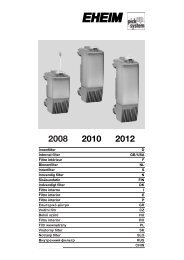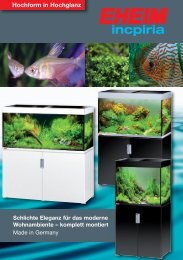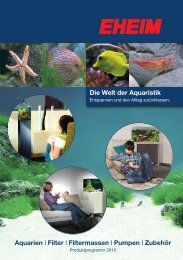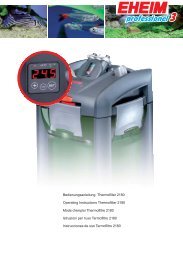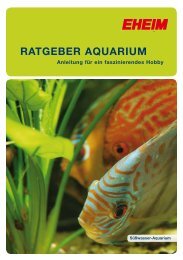Gebrauchsanleitung D Instructions GB / USA Mode d'emploi F - Eheim
Gebrauchsanleitung D Instructions GB / USA Mode d'emploi F - Eheim
Gebrauchsanleitung D Instructions GB / USA Mode d'emploi F - Eheim
You also want an ePaper? Increase the reach of your titles
YUMPU automatically turns print PDFs into web optimized ePapers that Google loves.
a) READ AND FOLLOW ALL SAFETY INSTRUCTIONS<br />
b) DANGER – To avoid possible electric shock, special care should be taken<br />
since water is employed in the use of aquarium equipment. For each of the<br />
following situations, do not attempt repairs by yourself; return the appliance<br />
to an authorized service facility for service or discard the appliance.<br />
1) If the appliance falls into the water, DON’T reach for it! First unplug<br />
it and then retrieve it. If electrical components of the appliance get wet,<br />
unplug the appliance immediately. (Non-immersible equipment only)<br />
2) If the appliance shows any sign of abnormal water leakage, immediately<br />
unplug it from the power source. (Immersible equipment only).<br />
3) Carefully examine the appliance after installation. It should not be<br />
plugged in if there is water on parts not intended to be wet.<br />
4) Do not operate any appliance if it has a damaged cord or plug, or if it<br />
is malfunctioning or has been dropped or damaged in any manner.<br />
5) To avoid the possibility of the appliance plug or receptacle getting wet,<br />
position aquarium stand and tank to one side of a wall-mounted receptacle<br />
to prevent water from dripping onto the receptacle or plug.<br />
A ”drip-loop”, shown in the figure, should be arranged by the user for<br />
each cord connecting an aquarium appliance to a receptacle.<br />
The ”drip-loop” is that part of the cord below the level of the receptacle,<br />
or the connector if an extension cord is used, to prevent water traveling<br />
along the cord and coming in contact with the receptacle.<br />
If the plug or socket does get wet, DON’T unplug the cord. Disconnect<br />
the fuse or circuit breaker that supplies power to the appliance. Then<br />
unplug and examine for presence of water in the receptacle.<br />
POWER SUPPLY CORD<br />
DRIP LOOP<br />
c) Close supervision is necessary when any appliance is used by or near<br />
children.<br />
d) To avoid injury, do not contact moving parts or hot parts such as heaters,<br />
reflectors, lamp bulbs, and the like.<br />
e) Always unplug an appliance from an outlet when not in use, before putting<br />
on or taking off parts, and before cleaning. Never yank cord to pull plug<br />
from outlet. Grasp the plug and pull to disconnect.<br />
f) Do not use an appliance for other than intended use. The use of attachments<br />
not recommended or sold by the appliance manufacturer may<br />
cause an unsafe condition.<br />
g) Do not install or store the appliances where it will be exposed to the<br />
weather or to temperatures below freezing.<br />
h) Make sure an appliance mounted on a tank is securely installed before<br />
operating it.


